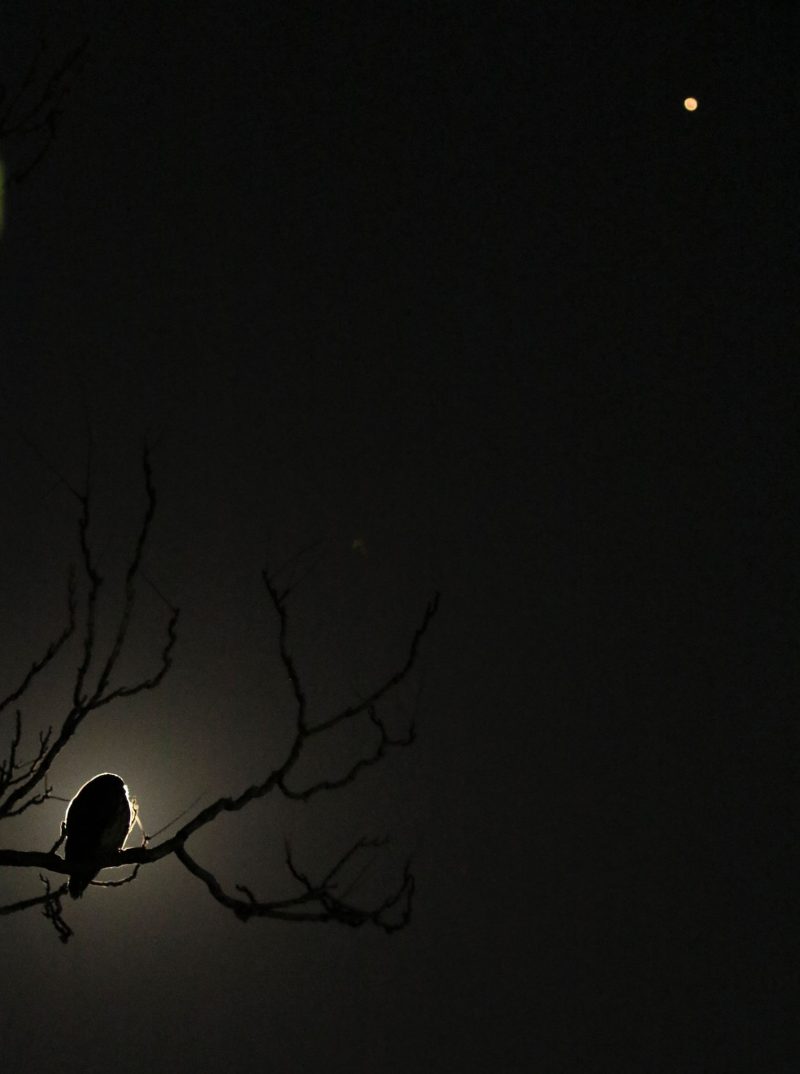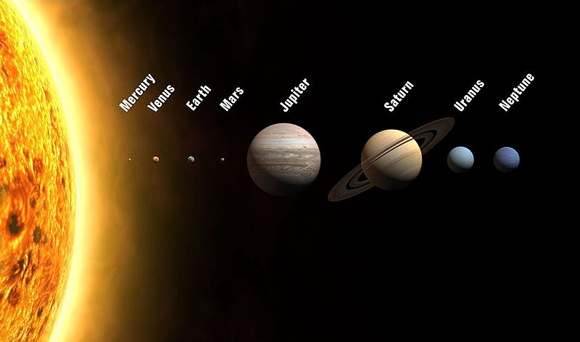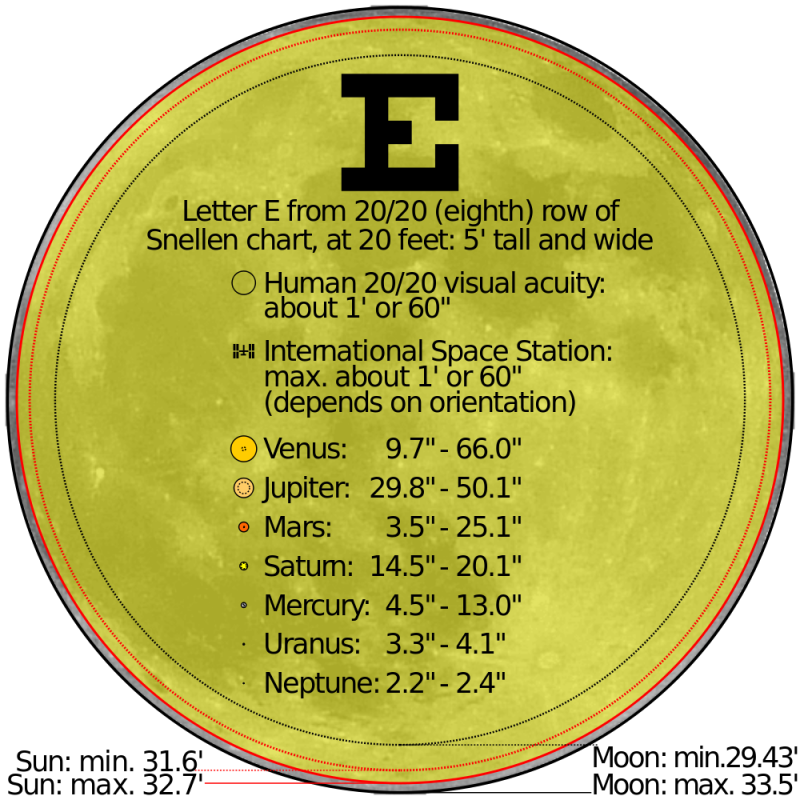
On November 24, 25 and 26, 2020, use the waxing gibbous moon to find the bright red planet Mars. For the fun of it, on our chart above, we also show the planet Uranus, 7th planet outward from the sun. You’re not likely to see Uranus with the eye alone in the moon’s glare, but you should have no trouble viewing bright Mars, which outshines Uranus by nearly 700 times.
You might see Uranus as a speck of light with binoculars. But you have to know right where to look on the sky’s dome, and it’s easier to star-hop your way to Uranus on a moonless night. For a sky chart, go to In-the-Sky.org.
You can’t miss Mars, no matter where you are on Earth. From the Northern Hemishpere, the red planet lords over the southeastern sky as darkness falls now. From the Southern Hemisphere, Mars is seen high in the northern sky at nightfall. Its fiery-red splendor lights up the nighttime well past midnight. In October 2020, Mars was brighter than it will be again until September 2035. That’s partly because – on October 13, 2020 – Mars reached opposition in our sky, when it was opposite the sun as seen from Earth. And it’s partly because this October 2020 opposition was a particularly favorable one.
At opposition in October, Earth was sweeping between Mars and the sun. Now – in its smaller, faster orbit – Earth is rushing along, leaving Mars behind. Thus, in the months ahead, Mars will slowly but surely dim in our nighttime sky.
Even so, Mars will remain bright and beautiful all throughout the rest of 2020.

View at EarthSky Community Photos. | Todd Hull in Seoul, South Korea captured this silhouette of an owl in front of the moon – with Mars nearby – on October 30, 2020. This photo was one of last month’s most popular photos at EarthSky. Todd wrote, “An owl (Northern Boobook) haloed by the nearly full moon—in the same frame with Mars. A once in a lifetime sight, and one you will never forget.” Glorious shot, Todd. Thank you!
We refer you to the ecliptic, the green line on our sky chart above. The ecliptic is the Earth’s orbital plane projected onto the constellations of the zodiac. In ancient times, when it was thought that the sun revolved around Earth (rather than the other way around), the ecliptic was regarded as the sun’s annual path in front of the backdrop stars.
For sky watching purposes, the ecliptic depicts the approximate plane of the solar system. Since the moon revolves around the Earth, and the planets revolve around the sun, on nearly the same plane that Earth orbits the sun, practiced sky watchers know the moon and solar system planets are always found on or near the ecliptic. The moon goes full circle in front of the constellations of the zodiac in about 27.3 days, Mars does so in about 1.88 Earth-years and Uranus in about 84 Earth-years.
Because Mars travels so much more swiftly along the ecliptic than does slow-plodding Uranus, Mars laps Uranus every other year. Mars last meet up with Uranus on February 13, 2019, and will next meet up with Uranus on the sky’s dome on January 21, 2021. At present, Mars and Uranus are about 22 degrees apart. But Mars will slowly gain on Uranus until their conjunction on January 21, 2020. Mars will be about 5 degrees west of Uranus on January 11, 2021, and then about 5 degrees east of Uranus on January 31, 2021. We mention this because a binocular field of view (FOV) typically spans 5 degrees.

Sizes of sun and planets to scale, but distances are not. Bill Nye demonstrates distances between planets

The angular diameters of the sun, moon and solar system planets as viewed from Earth. On November 24, 2020, the angular diameter of Mars is nearly 16.0 seconds of arc, whereas the angular diameter of Uranus = 3.7 seconds of arc. At their conjunction on January 21, 2021, the angular diameter of Mars = 8.6 seconds of arc whereas that of Uranus = 3.6 seconds of arc.
Bottom line: Use the moon to find the planet Mars on November 24, 25 and 26, 2020. Then use the planet Mars to find Uranus with Mars in a single binocular field in January 2021.
from EarthSky https://ift.tt/2J3RQa4

On November 24, 25 and 26, 2020, use the waxing gibbous moon to find the bright red planet Mars. For the fun of it, on our chart above, we also show the planet Uranus, 7th planet outward from the sun. You’re not likely to see Uranus with the eye alone in the moon’s glare, but you should have no trouble viewing bright Mars, which outshines Uranus by nearly 700 times.
You might see Uranus as a speck of light with binoculars. But you have to know right where to look on the sky’s dome, and it’s easier to star-hop your way to Uranus on a moonless night. For a sky chart, go to In-the-Sky.org.
You can’t miss Mars, no matter where you are on Earth. From the Northern Hemishpere, the red planet lords over the southeastern sky as darkness falls now. From the Southern Hemisphere, Mars is seen high in the northern sky at nightfall. Its fiery-red splendor lights up the nighttime well past midnight. In October 2020, Mars was brighter than it will be again until September 2035. That’s partly because – on October 13, 2020 – Mars reached opposition in our sky, when it was opposite the sun as seen from Earth. And it’s partly because this October 2020 opposition was a particularly favorable one.
At opposition in October, Earth was sweeping between Mars and the sun. Now – in its smaller, faster orbit – Earth is rushing along, leaving Mars behind. Thus, in the months ahead, Mars will slowly but surely dim in our nighttime sky.
Even so, Mars will remain bright and beautiful all throughout the rest of 2020.

View at EarthSky Community Photos. | Todd Hull in Seoul, South Korea captured this silhouette of an owl in front of the moon – with Mars nearby – on October 30, 2020. This photo was one of last month’s most popular photos at EarthSky. Todd wrote, “An owl (Northern Boobook) haloed by the nearly full moon—in the same frame with Mars. A once in a lifetime sight, and one you will never forget.” Glorious shot, Todd. Thank you!
We refer you to the ecliptic, the green line on our sky chart above. The ecliptic is the Earth’s orbital plane projected onto the constellations of the zodiac. In ancient times, when it was thought that the sun revolved around Earth (rather than the other way around), the ecliptic was regarded as the sun’s annual path in front of the backdrop stars.
For sky watching purposes, the ecliptic depicts the approximate plane of the solar system. Since the moon revolves around the Earth, and the planets revolve around the sun, on nearly the same plane that Earth orbits the sun, practiced sky watchers know the moon and solar system planets are always found on or near the ecliptic. The moon goes full circle in front of the constellations of the zodiac in about 27.3 days, Mars does so in about 1.88 Earth-years and Uranus in about 84 Earth-years.
Because Mars travels so much more swiftly along the ecliptic than does slow-plodding Uranus, Mars laps Uranus every other year. Mars last meet up with Uranus on February 13, 2019, and will next meet up with Uranus on the sky’s dome on January 21, 2021. At present, Mars and Uranus are about 22 degrees apart. But Mars will slowly gain on Uranus until their conjunction on January 21, 2020. Mars will be about 5 degrees west of Uranus on January 11, 2021, and then about 5 degrees east of Uranus on January 31, 2021. We mention this because a binocular field of view (FOV) typically spans 5 degrees.

Sizes of sun and planets to scale, but distances are not. Bill Nye demonstrates distances between planets

The angular diameters of the sun, moon and solar system planets as viewed from Earth. On November 24, 2020, the angular diameter of Mars is nearly 16.0 seconds of arc, whereas the angular diameter of Uranus = 3.7 seconds of arc. At their conjunction on January 21, 2021, the angular diameter of Mars = 8.6 seconds of arc whereas that of Uranus = 3.6 seconds of arc.
Bottom line: Use the moon to find the planet Mars on November 24, 25 and 26, 2020. Then use the planet Mars to find Uranus with Mars in a single binocular field in January 2021.
from EarthSky https://ift.tt/2J3RQa4

Aucun commentaire:
Enregistrer un commentaire